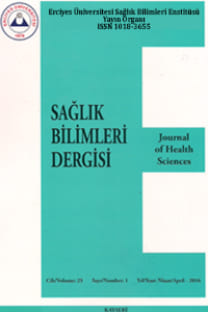VARIATION COMPARISON OF THEORETICALLY PREPARED DIETS TO THE DIETS PRACTICALLY SERVED TO CATTLE USING SIX SIGMA METHODS; 1-INVESTIGATION OF NUTRIENT VARIABILITY IN TMR RATION FOUR EXAMPLE ON DAIRY FARM
TEORİDE HAZIRLANAN RASYONLARIN PRATİK UYGULAMADAKİ VARYASYONLARININ ALTI SİGMA METODOLOJİSİ İLE ARAŞTIRILMASI; 1-TMR RASYONLARINDA BESİN MADDE DEĞİŞKENLİKLERİNİN DÖRT SÜT SIĞIRI ÇİFTLİĞİ ÖRNEĞİNDE İNCELENMESİ
___
- Işığıçok E. Altı Sigma Karakuşaklar İçin Hipotez Testleri Yol Haritası (Genişletilmiş 2. Baskı), Marmara Kitapevi, Bursa 2011:108
- Yalçın S, Şehu AR. Hayvan Beslenme ve Beslenme Hastalıkları (geliştirilmiş 5. Baskı), Pozitif, Ankara, 2011; s:699
- Deniz S. Rasyon Hazırlama. Rasyon, Hayvan Beslenme ve Beslenme Hastalıkları, Medipres Matbacılık, Malatya, 2008; s:461
- California Deparment of Food and Agriculture, California Cost Of Milk Production 2015 Annual, CFDA, Sacramento, 2016: p 7–14
- Linn J. Feeding Total Mixed Ration, Day To Day TMR Feeding, http://www.extension.umn.edu/ agriculture/dairy/feed-and-nutrition/feeding-totalmixed-rations/ (12.11.2016)
- Miller J. Ask your nutritionist about your TMR consitency. Western Dairy Business May 2012, http://www.diamondv.com/wp-content/uploads/ Reprint_Dairy_2012- 05_DairyBusiness_TMRConsistency.pdf (05.01.2017)
- Van Saun RJ, Smith RA. Veterinary Clinics of North America: Food Animal Practice, Dairy Nutrition, Elsevier, November 2014
- Heinrichs J, Kononoff P. Evaluating particle size of forages and TMRs using the New Penn State Forage Particle Separator, Department of Dairy and Animal Science The Pennsylvania State University, DAS 02- 42
- Friggens N, Emmans GC, Robertson S, et al. The lactational responses of dairy cows to amount of feed and to the source of carbohydrate Energy. J Dairy Sci 1995;78:1734–1744
- Stone B. Reducing the variation between formulated and consumed rations. WCDS Adv. in Dairy Technol 2008;20:145–162.
- Weiss WP, Shoemaker D, McBeth L, Yoder P, StPierre NR. Within farm variation in nutrient composition of feeds, Tri-State Dairy Nutrition Conference, Fort Wayne, IN, pages 103-117 117 in Proc, The Ohio State University, Columbus 2012
- Kutlu HR. Yem Değerlendirme ve Analiz Yöntemleri, Ders Notu, Adana, 2008:51
- Protein (Crude) Determination in Animal Feed: Copper Catalyst Kjeldahl Method. (984.13) Official Methods of Analysis. Association of Official Analytical Chemists. 15th Edition, 1990
- Fat (Crude) or Ether Extract in Animal Feed. (920.29) Official Methods of Analysis. Association of Official Analytical Chemists. 15th Edition, 1990
- Ash of Animal Feed. (942.05) Official methods of Analysis. Association of Official Analytical Chemists, 15th Edition, 1990
- Fiber (Acid Detergent) and Lignin in Animal Feed. (973.18) Official Methods of Analysis. Association of Official Analytical Chemists. 15th Edition, 1990
- Goering, HK, Van Soest PJ. Forage fiber analysis (apparatus, reagents, procedures, and some applications). USDA Agricultural Research Service. Handbook number 379 as modified by DR. Mertens (1992, Personal Communication), 1970
- Goering HK, Van Soest PJ. Forage fiber analysis (apparatus, reagents, procedures, and some applications). USDA Agricultural Research Service. Agriculture Handbook No. 379, 1970
- Nutrient Requirements of Dairy Cattle, Seventh Edition, Subcommittee on Dairy Cattle Nutrition Committee on Animal Nutrition Board on Agriculture and Natural Resources National Research Council, National Academy Press, Washington DC, 2001:13-25
- Heinrichs J. The Penn State Particle Separator, Department of Dairy and Animal Science The Pennsylvania State University, DSE 13-186
- Minitab 16.1.1, Minitab 16 Statistical Software
- Rossow HA, Aly SS. Variation in nutrients formulated and nutrients supplied on 5 California dairies, J. Dairy Sci 2013;96 :7371–7381
- Esmaeili M, Khorvash M, Ghorbani GR, Nasrollahi SM, Saebi M. Variation of TMR particle size and physical characteristics in commercial Iranian Holstein dairies and effects on eating behaviour, chewing activity, and milk production. Livestock Science 2016;191:22–28
- Sova AD, LeBlanc SJ, McBride BW, DeVries TJ. Accuracy and precision of total mixed rations fed on commercial dairy farms. J Dairy Sci 2016;97:562– 571
- Nutrient Requirements of Dairy Cattle, Seventh Edition, Subcommittee on Dairy Cattle Nutrition Committee on Animal Nutrition Board on Agriculture and Natural Resources National Research Council, National Academy Press, Washington DC, 2001
- Nutrient Requirements of Beef Cattle, Seventh Edition:Update 2000, Subcommittee on Beef Cattle Nutrition Committee on Animal Nutrition Board on Agriculture and Natural Resources National Research Council, National Academy Press, Washington DC, 1996
- ISSN: 1018-3655
- Yayın Aralığı: 3
- Başlangıç: 1993
- Yayıncı: Prof.Dr. Aykut ÖZDARENDELİ
IS THERE A RELATION BETWEEN ZINC LEVELS, AND RECURRENT RESPIRATORY SYSTEM I NFECTIONS IN CHILDREN?
Özlem Naciye ŞAHİN, Nuray KEÇECİOĞLU, Muhittin SERDAR, Aysel ÖZPINAR
Nusret APAYDIN, Görkem EKEBAŞ, Öznur ASLAN, Ayhan ATASEVER
BİGOREKSİYA: VÜCUT DİSMORFİK BOZUKLUĞU MU, YEME BOZUKLUĞU MU?
Gülsüm Nihal ÇÜRÜK, Sevda Korkut BAYINDIR, Abdurrahman OĞUZHAN
PARVOVİRUS İLE DOĞAL ENFEKTE KÖPEKLERDE MATRİKS METALLOPROTEİNAZ-9 EKSPRESYONU
Mehmet Önder KARAYİĞİT, Özhan KARATAŞ
KÖPEKLERDE BRAHİSEFALİK PİGMENTER KERATİTİS
BELLEĞİN EPİGENETİK DÜZENLENMESİ: MİKRORNA’LARIN ROLÜ
Sebahattin KARABULUT, Keziban Korkmaz BAYRAMOV, Asuman GÖLGELİ
OKSİDATİF STRESE KARŞI 3,4-DHPEA'NIN KORUYUCU ETKİSİNİN MODÜLASYONUNDA PTEN'İN ROLÜ
